For over seven decades, Tide has been a brand woven into the very fabric of American households. Introduced in 1946 by Procter & Gamble, Tide revolutionized laundry care by becoming the world’s first heavy-duty laundry detergent. Prior to Tide, laundry detergents were primarily mild, formulated for handwashing clothes. Tide ushered in a new era of machine-washable cleaning power, tackling the challenges of dirty clothes generated by a more active and modern lifestyle.
This innovation wasn’t born overnight. The story of Tide begins in the 1930s with a team of Procter & Gamble scientists, led by David Byerly, working on a mysterious project codenamed “Project X.” After years of meticulous research and development, they cracked the formula for a synthetic detergent specifically designed for the harsher conditions of machine washing. This groundbreaking formula, unlike its predecessors, could effectively remove tough dirt and stains, making laundry day a breeze.
Tide’s launch in 1946 was met with immediate success. Coined the “washday miracle,” Tide, along with the invention of washing machines, drastically changed the way households did laundry. By reducing the manual labor required, it freed up hours from household chores, allowing families more time for leisure and other activities. Tide’s iconic orange and yellow bull’s-eye logo, designed by renowned architect Donald Deskey, quickly became a symbol of cleaning power and trust.
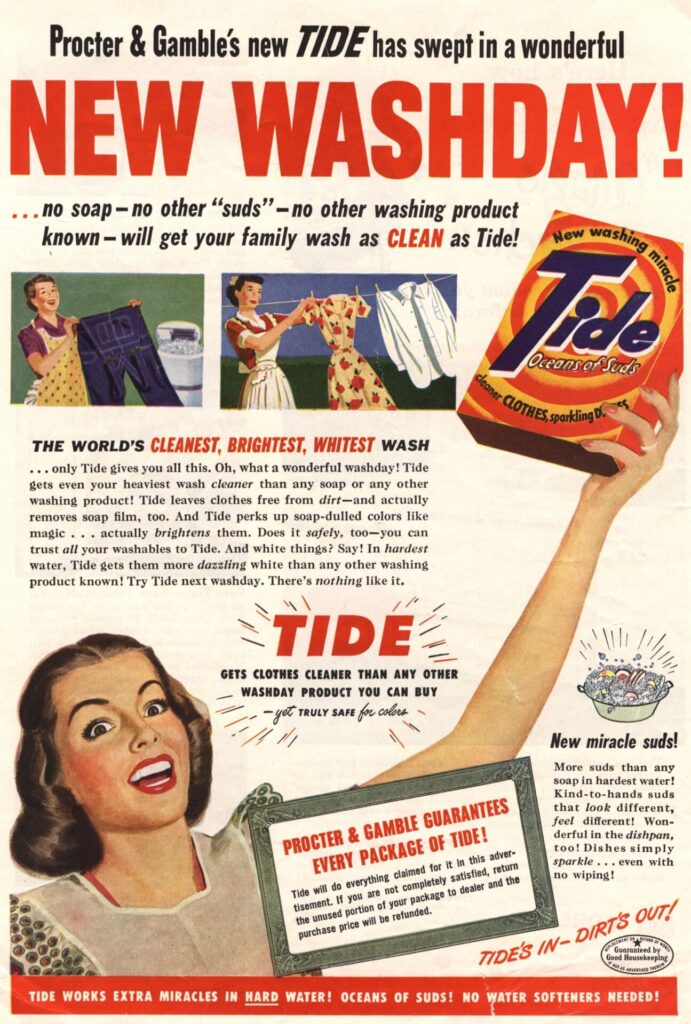
However, Tide’s journey wasn’t simply about capitalizing on its initial success. The brand has consistently demonstrated a commitment to innovation. In 1968, Tide XK became the first U.S. detergent formulated with enzymes, specifically designed to break down protein and carbohydrate stains for a deeper clean. Recognizing the shift towards convenience in the 1980s, Tide launched its liquid detergent formula, offering twice the cleaning power of existing liquid options on the market.
This dedication to progress hasn’t stopped. Tide continues to push the boundaries of laundry care, introducing revolutionary products like Tide Pods, the first single-dose laundry detergent pac, and Tide purclean, a plant-based detergent catering to eco-conscious consumers. Even venturing beyond cleaning, Tide has established initiatives like “Tide Loads of Hope,” which provides professional cleaning services to disaster-stricken communities.
Tide’s story is more than just a chronicle of a laundry detergent brand. It’s a testament to American ingenuity and a reflection of the evolving needs and lifestyles of families. As Tide continues to innovate and adapt, one thing remains certain: it will likely hold its place as a trusted partner in keeping clothes clean and families comfortable for generations to come.
Target Audience of Tide
Tide strategically directs its marketing efforts towards women aged 18 to 54 years old who fall within the middle-class demographic. This focus recognizes the reality that women are typically the primary caregivers within a household, shouldering a significant portion of the laundry responsibilities. Understanding these demographics allows Tide to tailor its messaging to resonate with the needs and concerns of this core audience.
The quintessential Tide consumer is often depicted as a mother who prioritizes both stain removal and keeping her family’s clothes looking their best for extended periods. Tide’s marketing reflects this by showcasing the effectiveness of their detergents in tackling tough stains, preserving the vibrancy of colors, and ensuring clothes maintain their shape and quality over numerous washes. This focus on practicality and longevity directly addresses the challenges faced by mothers who manage laundry for themselves and their families.
Tide’s multi-pronged marketing approach utilizes advertising, social media, and public relations to connect with its target audience. By featuring relatable women in their campaigns and highlighting the benefits of using Tide, the brand establishes itself as a trusted partner in the laundry room. Social media allows Tide to provide valuable tips and tricks, fostering a sense of community and brand loyalty. Finally, strategic public relations efforts, such as sponsorships aligned with their target audience’s interests, further solidify Tide’s position as a brand that understands and supports the needs of families.
Marketing Strategies of Tide
Tide employs a variety of marketing strategies to maintain its position as one of the leading laundry detergent brands globally. Here are some key elements of Tide’s marketing strategies:
1. Product Differentiation
Tide has carved out a distinct space in the laundry detergent market through strategic product differentiation. They offer a wide variety of choices at various price points, catering to different needs and budgets. This differentiation goes beyond just cost. Tide categorizes their products based on factors like scent, stain-fighting power, whitening properties, and even germ protection, ensuring customers can find the perfect solution for their specific laundry woes.
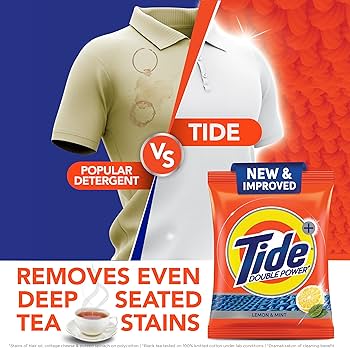
Furthermore, Tide segment their product lines into popular, premium, and super-premium tiers. This allows them to cater to value-conscious consumers while also offering high-performance options for those seeking top-of-the-line results. By strategically combining affordability with a premium brand image, Tide has established itself as a leader in the laundry care industry.
2. Brand Positioning
Tide has carved out a strategic brand position that prioritizes value and performance. They target middle and lower-middle-class families, both in urban and rural areas. Tide positions itself as a high-quality detergent at an affordable price, offering a compelling value proposition. This is achieved through competitive pricing with other premium brands, but with the addition of features like multiple fragrances, advanced cleaning technology, and even format options like their “matic” line for washing machines.
This value proposition is further strengthened by their brand messaging, centered around the concept of the “washday miracle.” Their advertising consistently portrays Tide as the solution for a cleaner, easier laundry experience. These campaigns often feature satisfied women showcasing the remarkable cleaning power of Tide, implying that Tide can transform laundry day from a chore into a breeze.
This strategic brand positioning has proven highly successful. Tide’s popularity as a global leader in laundry detergent is a testament to the effectiveness of their approach. Their strong brand image, coupled with their focus on value and performance, has resonated with consumers around the world, making Tide a household name in over 100 countries.
3. Advertising
Tide has built a long-lasting legacy in the US laundry detergent market through strategic advertising campaigns.
a. Focusing on the Emotional Benefit:
- The “Washday Miracle”: Tide’s iconic campaigns center around the concept of transforming laundry day from a dreaded chore into a positive experience. Their ads often feature relatable characters, typically women, who achieve sparkling clean clothes and newfound joy thanks to Tide’s cleaning power. This emotional connection resonates with viewers, portraying Tide as a solution that simplifies and even uplifts their lives.
b. Leveraging Humor and Pop Culture:
- Memorable Characters and Catchphrases: Tide’s ads aren’t afraid to be fun and humorous. They’ve introduced unforgettable characters like the Stain Guy and quirky celebrity endorsements to capture attention. Catchy slogans like “Tide, Clean Clothes. Clean Conscience” stay with viewers long after the commercial ends, reinforcing brand recognition.
- Pop Culture Integration: Tide stays relevant by incorporating popular trends and cultural moments into their campaigns. This keeps their advertising fresh and engaging for a broad audience in the US.
c. Demonstrating Cleaning Power with Science:
- Scientific Backing for Cleaning Claims: Tide doesn’t shy away from showcasing the science behind their powerful cleaning formulas. Visual demonstrations and clear messaging highlight how Tide tackles tough stains and leaves clothes looking their best. This blend of emotional appeal with scientific evidence creates a convincing and trustworthy brand image for American consumers.
By strategically combining these elements, Tide’s advertising campaigns have become a staple in American households. They effectively connect with viewers on an emotional level, leverage humor and pop culture for memorability, and provide scientific backing to solidify their position as a powerful and reliable laundry detergent brand.
4. Product Packaging
Tide leverages its product packaging as a key marketing tool. Bold and vibrant colors are a hallmark of their design, making their products stand out on crowded store shelves and grabbing the attention of consumers. This focus on visual appeal goes hand-in-hand with the extensive variety of Tide products. Pods, liquids, powders, and stain removers cater to different laundry needs, while classifications based on scent, whitening power, and germ protection offer further choice. This variety ensures customers can find a Tide product that perfectly aligns with their preferences.
Sustainability is another key consideration in Tide’s packaging strategy. They prioritize using recyclable materials (HDPE plastic for bottles and #5 PP for caps) wherever possible. Tide even boasts a partnership with TerraCycle to facilitate the recycling of used laundry bottles through an online platform. This commitment to environmental responsibility resonates with eco-conscious consumers, giving Tide an edge in a competitive market.
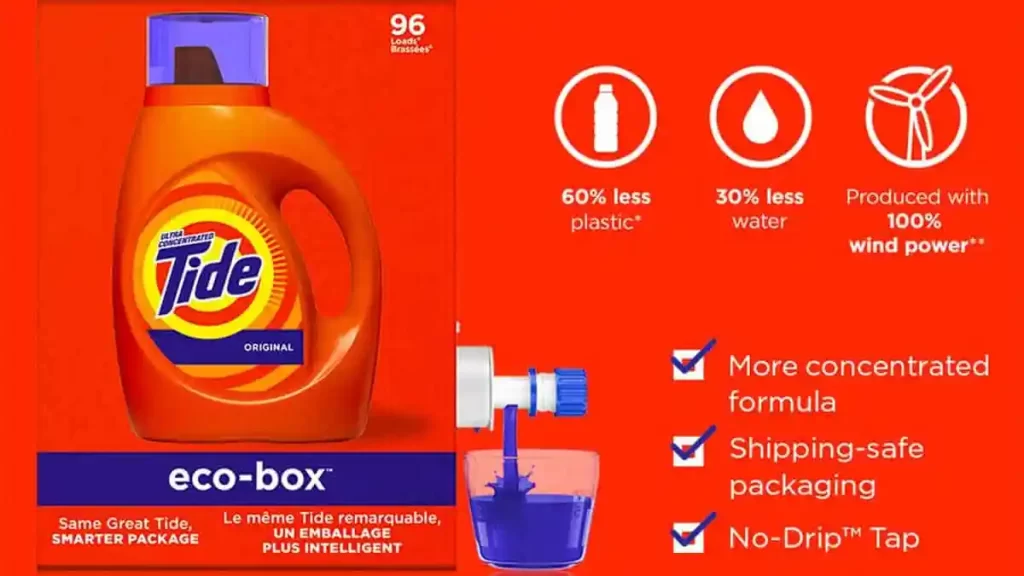
In conclusion, Tide’s packaging strategy excels on multiple fronts. The eye-catching design grabs attention, the product variety caters to diverse needs, and the focus on sustainability appeals to environmentally responsible consumers. By combining these elements, Tide effectively utilizes their packaging as a marketing tool to stand out, connect with customers, and promote their brand.
5. Continuous Innovation
Tide has remained a frontrunner in the laundry detergent market through a commitment to constant innovation. Here are some prime examples of their efforts:
Tide PODS revolutionized laundry care with their pre-measured, single-dose convenience. These pods not only simplified laundry day but also used less packaging and water compared to traditional liquid detergent. The water-soluble film dissolving in any water temperature further solidified their user-friendly design.
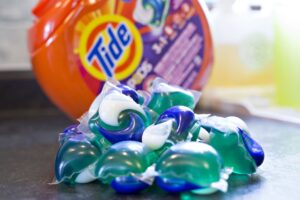
Sustainability is a key focus for Tide’s innovation. The Tide Eco-Box reimagines laundry detergent packaging. This solution utilizes 60% less plastic than traditional bottles, showcasing Tide’s commitment to reducing their environmental footprint.
Meeting the evolving needs of consumers is another pillar of Tide’s innovation strategy. Products like Tide purclean cater to environmentally conscious customers with a plant-based formula containing 75% renewable ingredients. Meanwhile, Tide Hygienic Clean tackles deep cleaning needs with its heavy-duty formula.
These examples highlight Tide’s dedication to continuous improvement. They constantly seek ways to make their products more convenient, effective, and sustainable, ensuring they stay at the forefront of the laundry care industry.
6. Digital Marketing
Tide has embraced the digital revolution, evolving its marketing strategy to reach customers through various online channels. Social media is a cornerstone of their digital efforts. They maintain active profiles on Facebook, Instagram, and Twitter, using these platforms to engage their audience with humorous and relatable content. This content is strategically crafted to resonate with their target demographic.
Beyond social media, Tide utilizes targeted online advertising campaigns. These campaigns leverage demographic data to reach potential customers who are more likely to be interested in their laundry care solutions. Email marketing is another tool in their digital arsenal. By communicating directly with existing customers, Tide can promote new products, highlight special offers, and foster brand loyalty.
The success of Tide’s digital marketing strategy lies in its multi-pronged approach. Their strong social media presence fosters engagement and brand awareness, while targeted online advertising and email marketing ensure they reach the right audience with the right message. By effectively navigating the digital landscape, Tide has secured a powerful platform to connect with consumers and promote their brand in the ever-evolving online world.
Overall, Tide’s marketing strategies focus on delivering superior product performance, building brand trust, engaging consumers through multiple touchpoints, and adapting to evolving market trends and consumer preferences.
Marketing Mix of Tide
Tide has carved its position through a strategic marketing mix. Let’s delve into the 4Ps that orchestrate this success:
1. Product
Variety: Tide boasts a vast product portfolio catering to diverse needs. From classic powder detergents to convenient pods and stain removers, Tide offers a solution for every laundry woe. They cater to regular, cold water, and high-efficiency (HE) washing machines, ensuring compatibility.
Innovation: Tide prioritizes continuous innovation. They’ve introduced features like built-in stain fighters, color protection formulas, and long-lasting freshness to address specific laundry concerns. Recent examples include Tide Pods with Downy and Spring Meadow scent, offering a touch of fabric softener and a pleasant fragrance.
Brand Extensions: Tide has expanded its brand beyond laundry detergents. Lines like Tide Cleaners (carpet and upholstery cleaners) and Tide Simply (natural laundry care) cater to niche markets and demonstrate brand adaptability.
2. Price
Mid-Range Strategy: Tide generally positions itself in the mid-price range. This sweet spot attracts value-conscious consumers while maintaining a perception of quality.
Price Variation: Tide employs price variations across product lines and sizes. Smaller containers or basic formulas might be cheaper, while premium features like stain fighters or pods come at a higher cost. This caters to budget variations within their target audience.
Promotions and Discounts: Tide frequently offers promotions and discounts through coupons, bundle deals, and store loyalty programs. This strategy incentivizes purchase and fosters brand loyalty.
3. Place
Extensive Distribution Network: Leveraging its parent company P&G’s vast network, Tide has secured a strong presence in supermarkets, hypermarkets, departmental stores, and convenience stores. This ensures easy accessibility for consumers.
Online Presence: Recognizing the e-commerce boom, Tide has made its products available on online retail platforms and its own website. This caters to the growing segment of online shoppers.
Focus on Visibility: Tide strategically places its products within stores. Eye-catching packaging and prominent shelf placement ensure consumers easily find their preferred Tide product.
4. Promotion
Multi-Channel Advertising: Tide utilizes a multi-channel advertising approach. They employ television commercials featuring memorable characters and catchy slogans to build brand recognition and emotional connection. Additionally, Tide leverages social media platforms and influencer marketing to target specific demographics and promote product features.
Cause Marketing: Tide occasionally engages in cause marketing initiatives, aligning itself with social causes that resonate with their target audience. This strategy fosters brand image and social responsibility.
Loyalty Programs: Tide has explored loyalty programs in certain markets. These programs reward repeat purchases with points redeemable for discounts or merchandise. This incentivizes brand loyalty and encourages long-term customer relationships.
Tide continuously monitors market trends and consumer preferences. This agility allows them to adjust their 4P mix. For example, the growing eco-conscious movement might see them introduce a wider range of eco-friendly laundry products.
By strategically orchestrating these elements, Tide has established itself as a laundry leader. Their marketing mix is a testament to the power of understanding consumer needs and delivering a compelling value proposition.
Advertising and Marketing Campaign Strategies of Tide
Tide has had many successful advertising and marketing campaigns in the United States. Some of the most famous include:
1. The “Tide Pod Challenge”
There actually was no “Tide Pod Challenge” campaign by Tide. It was a dangerous online trend in 2018 where people, primarily teens, dared each other to bite or eat Tide Pods (laundry detergent packets) and record themselves doing it.
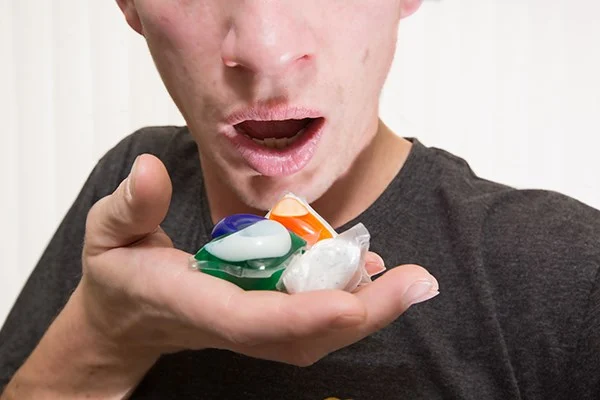
Here’s what happened:
- Tide Pods gained notoriety due to their bright colors and resemblance to candy, especially among young children.
- Online memes joked about how tempting Tide Pods looked, sparking the irresponsible “Tide Pod Challenge.”
- Tide, along with social media platforms like YouTube, actively discouraged this trend, emphasizing the dangers of ingesting laundry detergent.
It’s important to remember that Tide did not create or endorse this challenge. Their marketing efforts focus on the cleaning power and effectiveness of their laundry products, not the consumption of them.
2. The “Tide Ad” (Super Bowl 2018)
The “It’s a Tide Ad” campaign for Super Bowl 2018 was a stroke of marketing genius by Tide. Here’s the gist:
- Concept: Instead of running a single traditional Super Bowl ad, Tide hijacked the entire broadcast.
- Execution: Actor David Harbour appeared throughout various commercials, pointing out that if the clothes looked clean, it must be a Tide ad, even if it wasn’t for Tide itself.
- Humor & Social Media: The campaign’s humor and unexpected nature went viral. People on social media started using the hashtag #TideAd to jokingly point out clean clothes in anything they saw.
Impact:
- Brand Awareness: The campaign generated immense buzz and solidified Tide’s position in pop culture.
- Social Engagement: #TideAd trended on Twitter, showcasing the power of social media integration.
- Marketing Innovation: This campaign redefined Super Bowl advertising, proving a single, well-executed concept could outperform a barrage of traditional commercials.
3. The “Tide Loads of Hope” campaign
Tide Loads of Hope isn’t exactly a marketing campaign in the traditional sense. It’s a disaster relief program established by Tide in 2005. Here’s the heart of the initiative:
- Mission: To provide free laundry services and essential cleaning supplies to communities affected by natural disasters like hurricanes, floods, and wildfires.
- Mobile Laundromats: Tide deploys specially equipped trucks that function as mobile laundromats. These trucks are equipped with high-efficiency washers and dryers, allowing them to wash hundreds of loads of laundry per day.
- Partnership: Tide partners with organizations like Matthew 25 Ministries to ensure efficient disaster response and reach those in need.
- Impact: Since its inception, Tide Loads of Hope has served countless communities, providing clean clothes and a sense of normalcy during times of crisis. This fosters feelings of goodwill and strengthens Tide’s brand image as a socially responsible company.
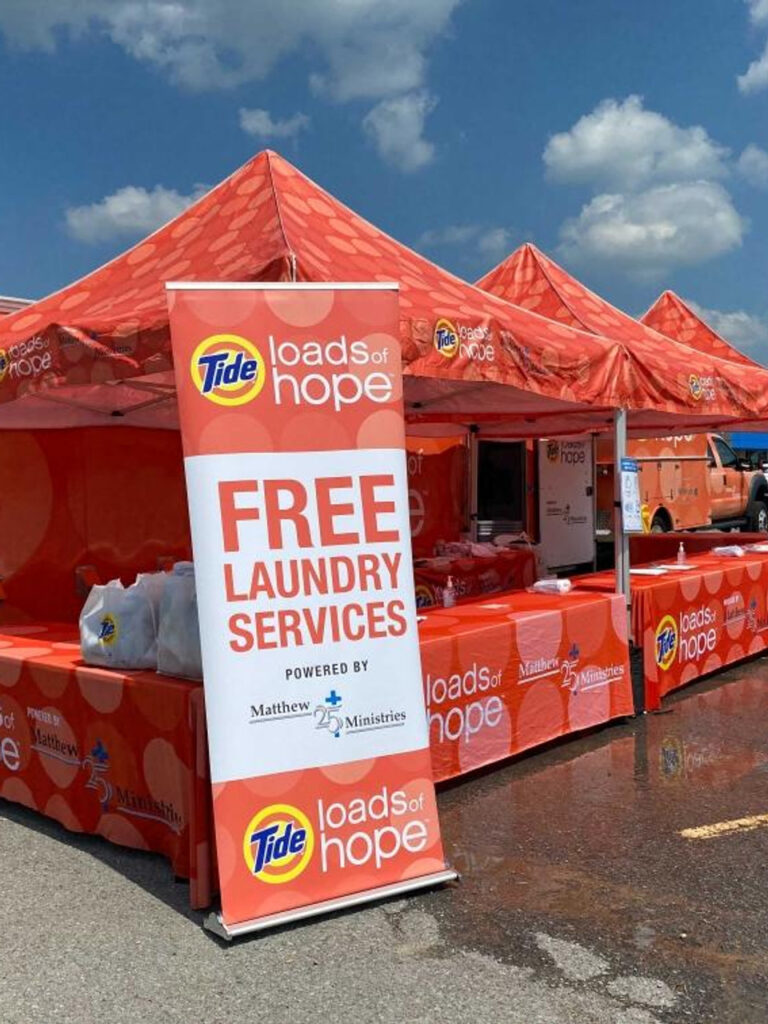
While not a direct marketing campaign, Tide Loads of Hope generates positive brand association and demonstrates Tide’s commitment to social good. This strategy indirectly complements their marketing efforts by portraying Tide as a brand that cares beyond just selling laundry detergent.
4. The Turn to Cold Campaign
The “Tide Turn to Cold” campaign, also known as the #TurnToCold movement, was a successful Tide initiative focused on promoting environmentally friendly laundry practices. Here’s a breakdown:
Goal: Encourage consumers to switch from hot or warm water washing to cold water.
Benefits Highlighted:
- Environmental Impact: Washing in cold water significantly reduces energy consumption, resulting in a smaller carbon footprint.
- Financial Savings: Cold water washing saves money on utility bills.
- Clothing Care: Cold water helps preserve the quality and color of clothes for longer.
Target Audience: The campaign targeted a broad audience, particularly eco-conscious consumers and those looking to save money.
Key Strategies:
- Partnership: Tide collaborated with influential figures like Ice-T, Stone Cold Steve Austin, and the World Wildlife Fund (WWF) to amplify the message.
- NFL Partnership: A strategic partnership with 16 NFL teams encouraged them to wash uniforms in cold water, setting an example for millions of fans.
- Media Outreach: The campaign utilized television commercials, social media engagement, and packaging changes to spread awareness.
- Product Innovation: Tide ensured its detergents were effective in cold water temperatures, addressing a potential consumer concern.
Success: The “Turn to Cold” campaign garnered significant results. It led to billions of impressions, a rise in cold water washing, and positioned Tide as a leader in sustainable laundry practices.
These are just a few of the many successful advertising and marketing campaigns that Tide has had in the United States. Tide is a brand that is known for its innovative and effective marketing, and its campaigns have helped to make it one of the most popular laundry detergent brands in the country.
Porter Five Forces of Tide
Michael Porter’s Five Forces framework helps us understand the competitive intensity of an industry. Let’s delve into each of the Five Forces to assess Tide’s competitive environment:
1. Threat of New Entrants: (Moderate)
High Capital Requirements: Establishing a nationwide laundry detergent brand requires significant investment in manufacturing, marketing, and distribution.
Brand Loyalty: Consumers often have established brand preferences, making it challenging for new entrants to gain traction.
Existing Distribution Channels: Large retailers often have established relationships with major brands, potentially limiting shelf space for newcomers.
However, factors like private label detergents and niche eco-friendly brands can pose a moderate threat.
2. Bargaining Power of Suppliers: (Moderate)
Limited Number of Key Raw Material Suppliers: The industry relies on a limited number of suppliers for raw materials like surfactants and enzymes. This could give suppliers some bargaining power.
Standardized Ingredients: Many laundry detergent ingredients are readily available, reducing supplier leverage over a specific brand like Tide.
Backward Integration: Large companies like P&G (Tide’s parent company) might have some backward integration, producing some of their own raw materials, further reducing supplier control.
Overall, the bargaining power of suppliers is moderate in Tide’s case.
3. Bargaining Power of Buyers: (Strong)
Large, Concentrated Retailers: Walmart, Costco, and other major retailers have significant buying power and can negotiate lower prices with detergent manufacturers.
Price Sensitivity of Consumers: Consumers are often price-sensitive when it comes to laundry detergent, giving retailers leverage to push for lower prices.
Availability of Private Label Brands: The presence of lower-priced private label detergents gives consumers more options and bargaining power.
The strong bargaining power of retailers is a significant challenge for Tide.
4. Threat of Substitutes: (Moderate)
Natural Cleaning Alternatives: Natural cleaning solutions like vinegar, baking soda, and borax can be seen as substitutes, particularly for eco-conscious consumers.
Laundry Service Providers: For some consumers, professional laundry services might be a substitute, though this caters to a different price point and level of convenience.
While substitutes exist, their effectiveness and convenience compared to Tide might not be a perfect match, keeping the threat moderate.
5. Competitive Rivalry: (High)
Highly Fragmented Industry: The laundry detergent industry is packed with competitors like Gain, Persil, Seventh Generation, and Arm & Hammer, all vying for market share.
Frequent Innovation: Brands constantly develop new features like stain fighters, color protection formulas, and eco-friendly options, leading to intense competition for consumer attention.
Price Wars and Promotions: To attract customers, companies often engage in price wars and offer frequent promotions, further intensifying competition.
The high level of competition in the laundry detergent industry pushes Tide to continuously innovate and maintain a strong brand image.
Overall, Porter’s Five Forces analysis reveals a moderately competitive landscape for Tide. While threats exist from new entrants, substitutes, and supplier power, the intense competition from established rivals and strong buyer power from retailers remain the key challenges for Tide to navigate. By focusing on product innovation, effective marketing strategies, and building strong relationships with retailers, Tide can maintain its position as a leader in the laundry detergent industry.
Also Read: Marketing Strategies and Marketing Mix of P&G
To reas more content like this, subscribe to our newsletter



